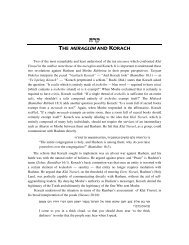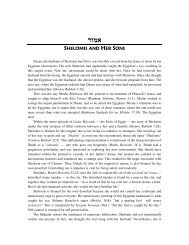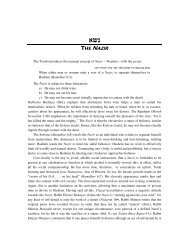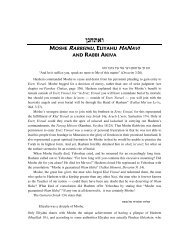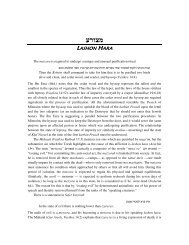ס×× × ××ר - Parsha Illuminations
ס×× × ××ר - Parsha Illuminations
ס×× × ××ר - Parsha Illuminations
You also want an ePaper? Increase the reach of your titles
YUMPU automatically turns print PDFs into web optimized ePapers that Google loves.
בהר סיניTHE TORAH IS OFFEREDTO THE NATIONSThe Gemara (Shabbos 89•) asks: why was Har Sinai — Mt. Sinai — given that particularname? The reason given is that at the time the Torah was presented at Har Sinai, a hatreddescended upon the nations. The words “Sinai” and “sinah” — “hatred” — bear a closeresemblance to one another. Rashi (ibid.) suggests that the hatred was directed from Hashemtoward the nations because they had rejected the Torah.As a prelude to Kabalas Hatorah, Hashem caused great natural disturbances in the world:“The mountains skipped like rams; the hills like young rams. What ails you, O sea, that you flee?O Jordan, that you turn backward?” (Tehillim 114:4,5; see Metzudas David, ibid.). ImmanuelVelikovsky (Worlds in Collision) cites sources from various ancient cultures that indicate that atthe period of Kabalas Hatorah volcanoes were erupting, and mountains were receding and beingbuilt all over the world. According to the old Tibetan traditions, the highlands of Tibet wereflooded in a great cataclysm, and terrifying comets caused great upheavals. Ancient Chinesehistory records that the sun did not set for a number of days, the forests were set on fire, andvermin filled the country. A high wave “reaching the sky” poured over the face of the land andswept water over the mountain peaks. The Mexican historical records tell of how the mountainsin every part of the Western hemisphere simultaneously gushed lava. Mountains swelled underthe pressure of molten masses and new ridges arose. The tribes of British Columbia tell: “Greatclouds appeared . . . such a great heat came, that finally the water boiled.” The Indian tribes of themore northern Pacific coast of America insist that the ocean boiled. The profile of the landchanged in a catastrophe, new valleys were formed, mountain ridges were torn apart, new gulfswere cut out, ancient heights were overturned and new ones sprang up. The Mayan relate thatmountains rolled and were removed, and great and small mountains moved and shook. TheHindus depict the cosmic catastrophe: “The whole world breaks into flames. All the peaks ofmountains . . . crumble and disappear in the sky. The flames of fire rise up and envelop theheaven.” The primitives of Africa, in the eastern and western provinces of the continent, tellabout the collapse of the sky. The tradition of the aborigines of western Brazil states that: “Thelightenings flashed and the thunders roared terribly and all were afraid.” The aborigines ofPaumotu in Polynesia relate that the earth was submerged into the ocean, and they reported thestrange sighting of a heavenly body. The Finnish historical records indicate that there weredisturbances in heaven; they thought that the support of the sky had given way. Velikovsky givesmany other examples of the recorded fear of many other nations who witnessed the great naturaldisturbances occurring during the seven weeks between Kerias Yam Suf and Kabalas Hatorah.
They felt that the end of the world was imminent as a result of these phenomena. This is alsoalluded to in the Song of Devorah:הרים נזלו מפני ה' זה סיניThe mountains melted at the presence of Hashem, this was at Sinai… (Shoftim5:5).Hashem desired to awaken the world from its complacency and alert mankind to thespectacular gift He was going to bestow upon Klal Yisrael. He desired that the nations should insome way join with Klal Yisrael in accepting Hashem’s Torah. If they desired, they could becomegerei tzedek —converts— as did the Eirev rav (See Rabbi Berliner and/or Rav Kook editions ofold girsa’os of Rashi, Shemos 12:38). Or at the very least, they could have become gerei toshav(Gentiles who have accepted the Noachide laws). This upheaval in nature was designed to shakethem from their contented state of mediocrity and galvanize them into achieving greatness.According to the Gemara (Avodah Zarah 2:) Hashem peddled the Torah “to every nation andevery tongue, but none accepted it until He came to Klal Yisrael, who received it.” Each nationhad a personal objection to a particular ethical principle of the Torah, and on the whole theyremained disinterested. The nations’ curiosity though were peaked by the disturbances, and theywere moved to approach their great men for an explanation of these events. Chazal indicate thatthere were at least three great men of world-class stature who understood what was occurring atthat time: Yisro, Iyov and Bilaam (Sotah 11•; Sanhedrin 106•). Yisro, the spiritual leader ofMidian, renounced idolatry, and called upon his countrymen to do likewise. He was denouncedand derided (Shemos Rabbah 1:32). Iyov was a righteous gentile and prophet (Bava Basra 15:)who resided in the land of Utz. He was in the company of other righteous individuals (BereishisRabbah 49:9), but was ineffectual in spiritually uplifting his generation. Bilaam, who resided inArum, was the greatest of them all. He was actually also a Navi of Hashem (Sanhedrin 106•), oneof seven Gentile prophets (Bava Basra 15:), and he was almost but not quite an equal of MosheRabbeinu (Sifri Devarim 34:10; Bamidbar Rabbah 20:1). It was Hashem’s intention that Bilaambring His message to the nations (ibid.). At the time of this upheaval of nature, all the nations senthim representatives to determine what was happening. Perhaps Hashem was consigning anotherflood to the world? Was Hashem demanding something of them? Were they required to doanything? Did they perhaps commit some transgression against Hashem? “Relax,” Bilaam said tothem, “Hashem has a precious gift in His treasury, which He wishes to bestow upon His children”(Zevachim 116•). End of story. He could have convinced them to take some proactive course onbehalf of Hashem. Moreover, they themselves could have persisted in their inquiries andcuriosity to effect a change in their lives. But it was not to be: in the midst of this earth shatteringtumult they were content to just return to their everyday mediocre existence. The nations had agreat opportunity, and they ignored it.Upon rejecting the Torah, the nations incurred Hashem’s wrath. Every human being isinvested with a fundamental potential for greatness. Man was created with an element of Divinity.ויפח באפיו נשמת חייםAnd [Hashem] breathed into his [man’s] nostrils the breath of life (Bereishis 2:7).
Hashem, so to speak, breathed into man a part of His own greatness (Ramban ibid.). The nationshad an opportunity to experience this greatness by bonding in some fashion with Klal Yisrael.They elected not to exercise their potential. At Kabalas Hatorah the nations are blamed for notrising above the “dust of the ground” (Bereishis 2:7), for not being interested in associating withHashem’s Torah. Hence, the hatred.Similarly, the gentile residents of the yeshivah town of Mata Mechasia are severely criticizedby the Sages (Berachos 17:). Mata Mechasia housed a formidable yeshiva all year round, buttwice a year the Yarchei Kalah was established there. During the Yarchei Kalah the city wasinundated with thousands upon thousands of people from the neighboring regions who desired tospend some time learning Torah. The city was then so crowded that people literally slept in thestreets; nevertheless the enthusiasm for Torah reached a fever pitch. The gentiles are criticized forliving in such a wonderful Torah environment and yet remaining indifferent to it. If anopportunity presents itself to man, man is expected to utilize it. Ignoring circumstances in whichone can activate his potential is reason enough for scorn.The Rambam (Igeres Teiman) offers another interpretation of “a hatred descended upon thenations.” The idolaters now became jealous of Klal Yisrael’s new elevated status. Moreover, thehostility displayed by the various nations and by their monarchs throughout the generations,against Klal Yisrael, was a result of their enmity of our superior position. As a result of thathatred, they sought to harass, decimate and destroy Klal Yisrael. The Ein Yaakov (Shabbos 89•)points out that to the gentiles, Klal Yisrael became the most despised of all the nations. Certainlyboth interpretations of “hatred” are accurate.Rashi (Bava Kama 38•) explains that as a result of the nations’ rejection of Hashem’s“peddling” efforts, they lost legal right to materialistic possession. For example, if a Jew’s oxgores a Canaani’s ox, there is no culpability (see Maharatz Chi’us ibid.). Punishment for rejectionof the Torah was that their possessions are now legally the property of Klal Yisrael. Man onlyneeds materialistic support if he is to use it for the acquisition of spiritual gain. If, however, herejects the importance of spiritual achievement, he has no need for materialistic benefits.Prior to Matan Torah all men were considered equal. Avraham Avinu shared his hospitalitywith all comers (Bereishis 18:2), all men were equally important. After Matan Torah the conceptof matanas chinam — gratuitous gift — no longer exists. Klal Yisrael proffers gratuitous gifts to“achicha bemitzvos” — “your brother in commandments” — but not to the nations. Klal Yisraelno longer represents regular nationhood; it is now a nation of superior beings ordained by aspirituality that soars far above the rest of mankind.מי כעמך ישראל, גוי אחד בארץWhich nation is like Israel, a unique nation in the world (Shabbos MinchahShemoneh Esrei).The other nations of the world are supporting actors on the stage of history, while Klal Yisrael isthe lead actor and always occupies center stage.ספינות הבאות מגליא לאספמיא, אינן מתברכות אלא בשביל ישראל[Even something as innocuous as] a ship traveling from France to Spain is onlyblessed for the benefit of Klal Yisrael (Yevamos 63•).
Whether it is recognized or unrecognized by mankind, the fact remains that Klal Yisrael is at thecenter of every world activity. It might sound chauvinistic to the unenlightened ear, but anythingthat happens anywhere on the planet occurs only because of the impact it has on Klal Yisrael,Hashem’s central world figure.By accepting the Torah, by accepting a contractual obligation to Hashem, Klal Yisraelthereby relinquished its independence. The most cherished possession of man is his autonomy,his ability to determine his own fate without interference from any outside force. Mankind likesto feel that it is in control of its own destiny. In this vein, Klal Yisrael was initially fiercelyprotective of its intellectual integrity, of its own mind, so to speak; but at Har Sinai, Klal Yisraelturned over its independent mind to the greater Mind of Hashem (see Rav Kook, Igros Rayah 36).Klal Yisrael now assumes the honored designation:“For they are My slaves ” (Vayikra 25:42).כי עבדי הםכי לי בני ישראל עבדים עבדי הם אשר הוצאתי אותם מארץ מצרים“For unto Me the children of Israel are slaves, they are My slaves, whom Ibrought forth out of the land of Egypt” (ibid. 55).At the same time, they are also referred to as:You are children to Hashem (Devarim 14:1).בנים אתם לה' אלק'חבבים ישראל שנקראו בנים למקום, חבה יתרה נודעת להם שנקראו לו בניםBeloved is Israel for they are called children of Hashem. It was an act of specialfavor that it was disclosed to them that they are called children [of Hashem](Pirkei Avos 3:14).Both terms of endearment are operative simultaneously (Kidushin 36•; Sifri, Devarim 32:5;see Bava Basra 10•).Hence, it is apparent that the events surrounding Sinai were a turning point in world history.Next to the actual creation of the world, Sinai stands as the single most spectacular event of alltime. It has determined the relations between Hashem and man, and the relationship between thenations and Klal Yisrael for eternity.aA



